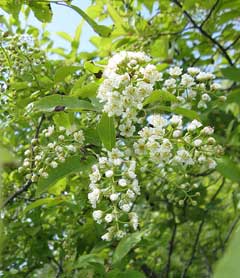
Chokecherry, Western chokecherry, Black chokecherry
Latin Name: Prunus virginiana
USDA Hardiness: Coming soon
Native Range: NORTHERN AMERICA: Canada, Northwest Territories (southwest), Québec (south), Nova Scotia, Ontario, New Brunswick, Newfoundland and Labrador, Saskatchewan, Alberta, Manitoba, British Columbia, United States, Connecticut, Indiana, Maine, Massachusetts, Michigan, New Hampshire, New Jersey, New York, Ohio, Pennsylvania, Rhode Island, Vermont, Illinois, Iowa, Kansas, Minnesota, Missouri, Nebraska, North Dakota, Oklahoma, South Dakota, Wisconsin, Colorado, Idaho, Montana, Oregon, Washington, Wyoming, Kentucky, Maryland, North Carolina (west), Tennessee, Virginia, New Mexico, Texas, Arizona, California, Nevada, Utah,
Edibility Rating: 3 / 5
Medicinal Rating: 2 / 5
Region:
Family:
Plant Type:
Medicinal Uses
Edible Uses
Edible Parts: Fruit Seed | Edible Uses: TeaFruit - raw or cooked[2, 55, 62, 159]. Very harsh, it is normally used in pies, jellies etc[155, 183]. Dark and juicy, it is sometimes edible raw when fully mature[82, 101]. The fruit can be dried and is then quite nice raw[85]. The fruit is up to 8mm in diameter and contains a single large seed[227]. Seed - raw or cooked. Very nutritious, they are added to pemmican[183]. Do not eat the seed if it is too bitter - see the notes above on toxicity. The bark and twigs are a tea substitute[161, 183].
Cultivation
Requires a well-drained moisture retentive soil[11]. Requires a sunny position[11]. Thrives in a loamy soil, doing well on limestone[11]. Prefers some chalk in the soil but apt to become chlorotic if too much is present[1]. A fast-growing but short-lived tree in the wild[229], it has a tendency to form thickets of considerable extent from root sprouts[227]. Sometimes cultivated for its edible fruit, and sold in local markets[46], there are a number of named varieties some of which have much less astringent fruit[183]. The fruit is not very freely borne in Britain[11], though good crops are borne almost annually in the wild[227]. Most members of this genus are shallow-rooted and will produce suckers if the roots are damaged[238]. Plants in this genus are notably susceptible to honey fungus[200]. The plant is heat tolerant in zones 8 through 1. (Plant Hardiness Zones show how well plants withstand cold winter temperatures. Plant Heat Zones show when plants would start suffering from the heat. The Plant Heat Zone map is based on the number of "heat days" experienced in a given area where the temperature climbs to over 86 degrees F (30°C). At this temperature, many plants begin to suffer physiological damage. Heat Zones range from 1 (no heat days) to 12 (210 or more heat days). For example Heat Zone. 11-1 indicates that the plant is heat tolerant in zones 11 through 1.) For polyculture design as well as the above-ground architecture (form - tree, shrub etc. and size shown above) information on the habit and root pattern is also useful and given here if available. A sprouting standard sending up shoots from the base [1-2]. The root pattern is flat with shallow roots forming a plate near the soil surface [1-2]. The root pattern is suckering with new plants from underground runners away from the plant [1-2]. Harvesting typically occurs in late summer to early autumn, with specific timing varying by species. For instance, plums and peaches are usually harvested from July to September (Northern Hemisphere), while almonds are harvested in August to September (Northern Hemisphere). Prunus species usually flower in early spring, often between March and April (Northern Hemisphere), depending on the species and local climate. Growth rates vary among species, but generally, Prunus trees can grow moderately fast, often reaching full height in 3 to 5 years. However, they may take several years to bear fruit, depending on the species and growing conditions.
Known Hazards
The seed can contain high concentrations of hydrogen cyanide, a poison that gives almonds their characteristic flavour. This toxin is readily detected by its bitter taste. Usually present in too small a quantity to do any harm, any very bitter seed or fruit should not be eaten[65]. In small quantities, hydrogen cyanide has been shown to stimulate respiration and improve digestion, it is also claimed to be of benefit in the treatment of cancer. In excess, however, it can cause respiratory failure and even death.
Habitats
Rich, rather moist soils, in thickets, borders of woods and on shores[43].
